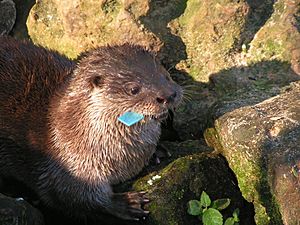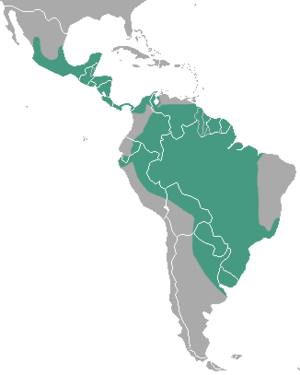Neotropical otter facts for kids
Quick facts for kids Neotropical otter |
|
|---|---|
 |
|
| Conservation status | |
| Scientific classification | |
| Genus: |
Lontra
|
| Species: |
longicaudis
|
 |
|
| Neotropical otter range | |
The neotropical otter or neotropical river otter (Lontra longicaudis) is a type of otter. These playful mammals live near water in Central America, South America, and on the island of Trinidad. They are known for their sleek bodies and love for swimming.
Neotropical otters are medium-sized. They usually measure from 36 to 66 centimetres (14 to 26 inches) long, not including their tail. Their weight can range from 5 to 15 kilograms (11 to 33 pounds). This makes them one of the smaller otter species.
Contents
Where They Live: Habitat
Neotropical otters are found in many different watery places. They prefer clear, fast-flowing rivers and streams. You can also find them in lakes, swamps, and even coastal areas. They need places with plenty of plants and rocks for cover.
These otters are very good at adapting to their surroundings. They can live in both tropical rainforests and drier forests. They often choose areas with dense plant life along the riverbanks. This helps them hide from predators and find food.
Their Homes: Dens
Otters create their homes, called dens or "holts," near the water. They might dig burrows into riverbanks. Sometimes, they use natural shelters like hollow logs or rock crevices. These dens provide a safe place to rest, raise their young, and escape bad weather.
What They Eat: Diet
Neotropical otters are carnivores, meaning they eat meat. Their diet mainly consists of fish. They are excellent hunters in the water. They use their strong bodies and sharp teeth to catch slippery prey.
Besides fish, they also eat other small animals. This can include crustaceans like crabs and crayfish. They might also hunt amphibians such as frogs, and even some small birds or reptiles. Their varied diet helps them survive in different environments.
How They Behave: Lifestyle
Neotropical otters are mostly active during the day. However, in areas with more human activity, they might become nocturnal. This means they hunt and move around more at night to avoid people. They are generally solitary animals. This means they prefer to live alone rather than in groups.
They are very playful creatures. Otters often slide down muddy banks into the water. They also chase each other and play with objects they find. This playful behavior helps them learn hunting skills and stay agile.
Communication
Otters communicate in several ways. They use different sounds, like chirps, growls, and whistles. They also use scent marking. They rub their bodies on rocks or logs to leave their unique smell. This helps them mark their territory and let other otters know they are around.
Life Cycle and Reproduction
The reproduction of neotropical otters is not fully understood. However, we know they typically have one litter of pups per year. The female otter usually gives birth to one to five young. The pups are born blind and helpless.
The mother otter cares for her young in the den. She teaches them how to swim and hunt. The pups stay with their mother for several months. They learn important survival skills before becoming independent.
Conservation Status
The neotropical otter is listed as "Near Threatened" by the International Union for Conservation of Nature (IUCN). This means their numbers are decreasing. They could become endangered if threats continue.
Threats to Otters
Several things threaten neotropical otters. One major threat is habitat loss. Rivers and wetlands are being destroyed or polluted by human activities. Pollution from farming and industry harms their food sources and makes them sick.
Hunting and poaching also pose a risk. Sometimes, otters are hunted for their fur. They can also get caught accidentally in fishing nets. Protecting their habitats and reducing pollution are key to helping these amazing animals survive.
See also
 In Spanish: Lobito de río para niños
In Spanish: Lobito de río para niños


